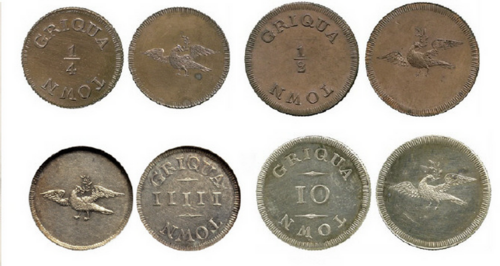Griqua coinage
[2] The Griqua, a racially and culturally mixed group, descended mainly from intermarriage and sexual relationships between indigenous Khoikhoi, slave mothers and European male colonists.
During his visit to the town on 7 August 1813 John Campbell, a Director of the London Missionary Society thought the name Bastaards to be offensive.
[3] Early Griquas consisting mostly of Bastaard families moved circa 1780 from the northern section of the Cape colony to settle along the Orange River.
Although the Kok and Barends families probably controlled the affairs of the Griquas who settled with them, autonomous groups formed in the area.
Immigrants also settled in the area, establishing claims to fountains and pans while retaining links with the Griqua leadership.
The Griquas were formidable traders who understood the concept of money, acting as middlemen between the colony and the northern nations.
At the meeting of 7 August 1813 various other issues were discussed, including coinage, where "It was likewise resolved that as they had no circulating medium amongst them by which they could purchase any small article, such as knives, scissors, etc.
[citation needed] At the weekly meeting of the Directors of the London Missionary Society held on 15 January 1816, it was "Resolved that the following Gentlemen be a Committee for considering of the best mode of furnishing a Silver Coinage for Griqua Town vizt Messrs Campbell, Muston, Steven & Bateman".
[5] Two months later, at a meeting of the Directors held at their meeting rooms in the Old Jewry on 22 April 1816, it was “Resolved that £100 be voted for a Silver Coinage as a circulating medium at Griqua Town & its Vicinity in So Africa - that this business be referred to Messrs Bateman and Muston”[5] On 10 May 1816 at the 22nd annual meeting (covering the 1815/1816 period) of the London Missionary Society, it was reported that "An Auxiliary Mission Society has been established in Griquatown, the subscribers to which, having no money (for money is utterly unknown in that part of the world) have contributed property which is to be sold for the benefit of the Society.
…To remedy the inconvenience sustained by the people, (who have now made considerable progress in civilization,) by their want of a circulating medium, the Directors are now procuring for them a coinage of silver tokens".
[6] On 15 July 1816 it was "Resolved that £200 in Coins [struck through] Tokens for use…as inflation…Griqua Town be forwarded to the Cape of Good Hope instead of £100 only - as before ordered".
[7] At a meeting held on 21 October 1816 it was recorded that "The following bills were ordered to be paid…William Westall…Silver Tokens £191.12"[5] The LMS Home Board Minutes record that at the meeting on 23 December 1816 it was “Resolved that Mr Bateman be reimbursed by this Society for the loss sustained by him in consequence of his boy being robbed of a quantity of Silver, for Tokens, gratuitously procured by Mr Bateman for the use of the Settlement at GriquaTown”[5] In the following volume, it is recorded that at a meeting of the Directors on 27 January 1817 "The Sum of £49 [was] voted to Mr Bateman on the 23rd of Decmbr last in compensation for his loss, by the robbery of his boy of the Silver, for Tokens, ordered"[5] The donations register for the London Missionary Society for the period March 1816 to March 1817 reports "Cash in Exchange for Griqua Tokens, per Mr Langton - £3.8.0"[8] (David Langton was the assistant secretary and treasurer of the London Missionary Society during this period).
An excerpt from the letter reads: “Sir, We acknowledge the receipt of Yours dated 20 March last and have the honor to return for Answer, that we have received the two Cases, containing small Silver Specie and Copper pieces in good order, and we will act with the same according to the intention and wish of the Society”.
On his second visit to South Africa, John Campbell visited the Griqua mission station again and noted in his diary on 8 August 1820: “The Landdrost (Andries Stockenstroom) thought it important to establish a regular communication between Griquatown and Graaff Reynet; also advised to apply to Government for sanction to the passing of the Griqua money in Graaff Reynet and Beaufort districts”.
[9] (The two districts were part of the Cape Colony, while Griquatown was not) A few days later, on 12 August, Campbell wrote: “Conversed also on the coin.
I promised to apply to the Governor to sanction its passing in the districts of Graaff-Reynet and Beaufort.”[9] Heinrich Helm, resident missionary of Griquatown, in a letter dated 21 June 1821 to the LMS representative in South Africa, Dr John Philip, wrote: “The greatest part of the Griqua money is still our Society’s property which Br.
6) In July 1817 it was confirmed by the LMS agent in Cape Town that both copper and silver coinage arrived in South Africa.


